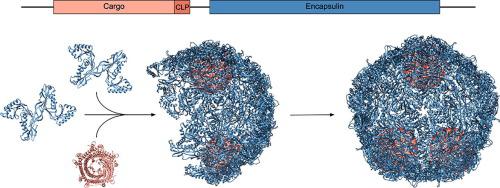Coordination Chemistry Reviews ( IF 20.3 ) Pub Date : 2021-09-08 , DOI: 10.1016/j.ccr.2021.214188 Ana V. Almeida 1 , Ana J. Carvalho 1 , Alice S. Pereira 1

|
Compartmentalization is an essential process that allows cells to organize, creating controlled microenvironments for specific metabolic pathways. Therefore, this allows the increase of reaction rates and/or protection of the cell from the effect of harmful substrates or products. Prokaryotes produce protein-based compartments by self-assembly of the protomers. Smaller and less complex than the eukaryotic organelles, they are designated as micro/nanocompartments. Encapsulins, one of the nanocompartments recently described, are protein nanocages that have the ability of sequestering other smaller proteins (cargo proteins) within their inner cavity. Depending on the organism, these porous nanocompartments can have different sizes and can encapsulate more than one type of cargo proteins, native or exogeneous. The physiological function of encapsulins is still unknown but seems to be determined by the type of encapsulated cargo proteins. The involvement of encapsulins in the iron metabolism and defense mechanisms against stress (oxidative and nutrient limitation) is nowadays consensual.
Although significant progress has been made to understand the structural properties of encapsulins, much remain to be elucidated such as the mechanism of encapsulation or their physiological function. The present manuscript reviews not only the findings made at the structural level, for both the encapsulin shell and cargo proteins, as well as their functions so far described. The use of encapsulins as nanoreactors, nanomaterials, delivery platforms for diagnosis and therapeutics or imaging probes have been recently boosted and is also reviewed.
中文翻译:

Encapsulin 纳米笼:蛋白质封装和铁螯合
区室化是一个重要的过程,它允许细胞组织,为特定的代谢途径创造受控的微环境。因此,这允许增加反应速率和/或保护细胞免受有害底物或产物的影响。原核生物通过原体的自组装产生基于蛋白质的区室。它们比真核细胞器更小、更简单,被称为微/纳米隔室。Encapsulins 是最近描述的纳米隔室之一,是蛋白质纳米笼,能够将其他较小的蛋白质(货物蛋白质)隔离在其内腔中。根据生物体的不同,这些多孔纳米隔室可以具有不同的尺寸,并且可以封装不止一种类型的货物蛋白质,天然的或外源的。封装蛋白的生理功能仍然未知,但似乎由封装的货物蛋白的类型决定。胶囊蛋白参与铁代谢和抗应激(氧化和营养限制)的防御机制,如今已成为共识。
尽管在理解封装蛋白的结构特性方面取得了重大进展,但仍有许多需要阐明的内容,例如封装机制或其生理功能。本手稿不仅回顾了结构水平上的发现,包括封装蛋白壳和货物蛋白,以及迄今为止描述的它们的功能。胶囊素作为纳米反应器、纳米材料、用于诊断和治疗的递送平台或成像探针的使用最近得到了推动,并且也进行了审查。











































 京公网安备 11010802027423号
京公网安备 11010802027423号